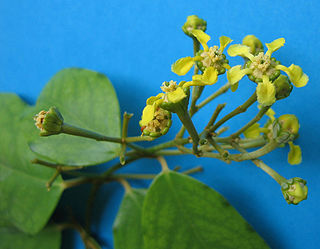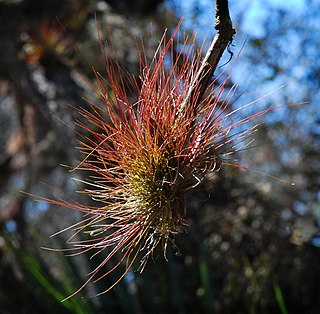
Chusquea is a genus of evergreen bamboos in the grass family. Most of them are native to mountain habitats in Latin America, from Mexico to southern Chile and Argentina.

Malpighiaceae is a family of flowering plants in the order Malpighiales. It comprises about 73 genera and 1315 species, all of which are native to the tropics and subtropics. About 80% of the genera and 90% of the species occur in the New World and the rest in the Old World.
Adelphia is a genus in the Malpighiaceae, a family of about 75 genera of flowering plants in the order Malpighiales. Adelphia comprises four species of woody vines native to the West Indies, Mesoamerica, and western South America.

Heteropterys is a genus in the Malpighiaceae, a family of about 75 genera of flowering plants in the order Malpighiales. Heteropterys comprises over 140 species of woody vines, shrubs, and small trees found in the New World tropics and subtropics from northern Mexico and the West Indies to northern Argentina and southeastern Brazil. One widespread, mostly Caribbean species, H. leona, is also found in low wet places along the coast of West Africa from Senegal to Angola.
Malpighiodes is a genus in the Malpighiaceae, a family of about 75 genera of flowering plants in the order Malpighiales. Malpighiodes comprises 4 species of woody vines native to northern South America. They are found in northern Brazil, French Guiana, Guyana, Suriname and Venezuela.
Barnebya is a genus in the Malpighiaceae, a family of about 75 genera of flowering plants in the order Malpighiales. Barnebya comprises 2 species of trees and woody vines native to eastern Brazil. The genus is named in honor of the American botanist Rupert Charles Barneby (1911–2006).

Peixotoa is a genus in the Malpighiaceae, a family of about 75 genera of flowering plants in the order Malpighiales. Peixotoa comprises 29 species of vines, shrubs, and subshrubs native to Brazil and adjacent Paraguay and Bolivia.

Hiraea is a genus in the Malpighiaceae, a family of about 75 genera of flowering plants in the order Malpighiales. Hiraea comprises over 55 species of woody vines and shrubs found in diverse habitats, except very dry vegetation types, in the New World tropics and subtropics from western Mexico to Paraguay and adjacent Argentina and southeastern Brazil; it also occurs in the Lesser Antilles in Grenada and St. Lucia.

Mascagnia is a genus in the Malpighiaceae, a family of about 75 genera of flowering plants in the order Malpighiales. The genus Mascagnia comprises about 45 species that occur in diverse habitats from northern Mexico and the Caribbean to northern Argentina and south-eastern Brazil.

Roupala is a Neotropical genus of woody shrubs and trees in the plant family Proteaceae. Its 34 species are generally found in forests from sea level to 4000 m altitude from Mexico to Argentina.

Microgramma is a genus of ferns in the family Polypodiaceae, subfamily Polypodioideae, according to the Pteridophyte Phylogeny Group classification of 2016 (PPG I). They are commonly known as vine ferns or snakeferns.
Psychopterys is a genus in the Malpighiaceae, a family of about 75 genera of flowering plants in the order Malpighiales. Psychopterys comprises 8 species of woody vines, occasionally described as shrubs or small trees, which occur in matorral, tropical deciduous forest, and wet forest in southern Mexico, Guatemala, and Belize. This genus is very distinctive because of its nearly radial white corollas and eglandular sepals, which are highly unusual characteristics in the Malpighiaceae of the New World.

Callaeum is a genus in the Malpighiaceae, a family of about 75 genera of flowering plants in the order Malpighiales. Callaeum comprises 11 species of woody vines and shrubs occurring from western Texas to Mexico, Central America, and South America. Two species, C. macropterum and C. septentrionale are cultivated as ornamentals in Arizona and California.
Bronwenia is a genus in the Malpighiaceae, a family of about 75 genera of flowering plants in the order Malpighiales. Bronwenia comprises 10 species of shrubs and woody vines native to Mexico, Central America, and South America.
Isocarpha (pearlhead) is a genus of flowering plants in the family Asteraceae. They are native to Mexico, Central America, the West Indies, and northern South America, with the range of one species extending north into the United States.

Pterocaulon is a genus of flowering plants in the sunflower family, native to North and South America and to Australasia. Blackroot is a common name for species native to North America.

Triphora is a genus of flowering plants from the orchid family, Orchidaceae. It is native to South America, Central America, southern Mexico, the West Indies and eastern North America as far north as Ontario. Noddingcaps is a common name for plants in this genus.
- Triphora amazonicaSchltr. - Florida, Caribbean, south to Brazil
- Triphora carnosula(Rchb.f.) Schltr. - Brazil
- Triphora craigheadiiLuer - Florida
- Triphora debilis(Schltr.) Schltr. - southern Mexico, Costa Rica, Guatemala, Panama
- Triphora duckeiSchltr. - Brazil
- Triphora foldatsiiCarnevali - Venezuela
- Triphora gentianoides(Sw.) Nutt. ex Ames & Schltr. - Florida, Southern Mexico, Costa Rica, Veenzuela, Colombia, Ecuador, Bahamas, Greater Antilles
- Triphora hassleriana(Cogn. ex Chodat & Hassl.) Schltr. - from Mexico to Argentina
- Triphora heringeriPabst - Brazil
- Triphora miserrima(Cogn.) Acuña - Cuba, Hispaniola
- Triphora nitida(Schltr.) Schltr. - Costa Rica
- Triphora pusilla(Rchb.f. & Warm.) Schltr. - Brazil
- Triphora ravenii(L.O.Williams) Garay - Costa Rica, Panama
- Triphora santamariensisPortalet - Brazil
- Triphora surinamensis(Lindl. ex Benth.) Britton - West Indies south to Brazil
- Triphora trianthophoros(Sw.) Rydb. Ontario, Eastern United States, much of Mexico
- Triphora unifloraA.W.C.Ferreira, Baptista & Pansarin - Brazil
- Triphora wagneriSchltr. - from Mexico to Ecuador
- Triphora yucatanensisAmes - Florida and the Yucatán Peninsula

Tillandsia setacea, the southern needleleaf, is a species of flowering plant in the genus Tillandsia. It has a scattered, disjunct distribution in the southeastern United States, northwestern and southern Mexico, Guatemala, the West Indies and the State of Pará in northeastern Brazil.
Callaeum antifebrile is a South American jungle vine of the family Malpighiaceae which occurs predominantly throughout the Upper Amazon basin, and less frequently along the Lower Amazon. Occasionally a component in ayahuasca decoctions, it is used as a folk medicine in some parts of Brazil, often as an antifebrile (anti-fever) remedy.

Madagasikaria is a genus in the Malpighiaceae, a family of about 75 genera of flowering plants in the order Malpighiales. Madagasikaria contains only one species of woody vine native to deciduous seasonally dry forest of Madagascar.













